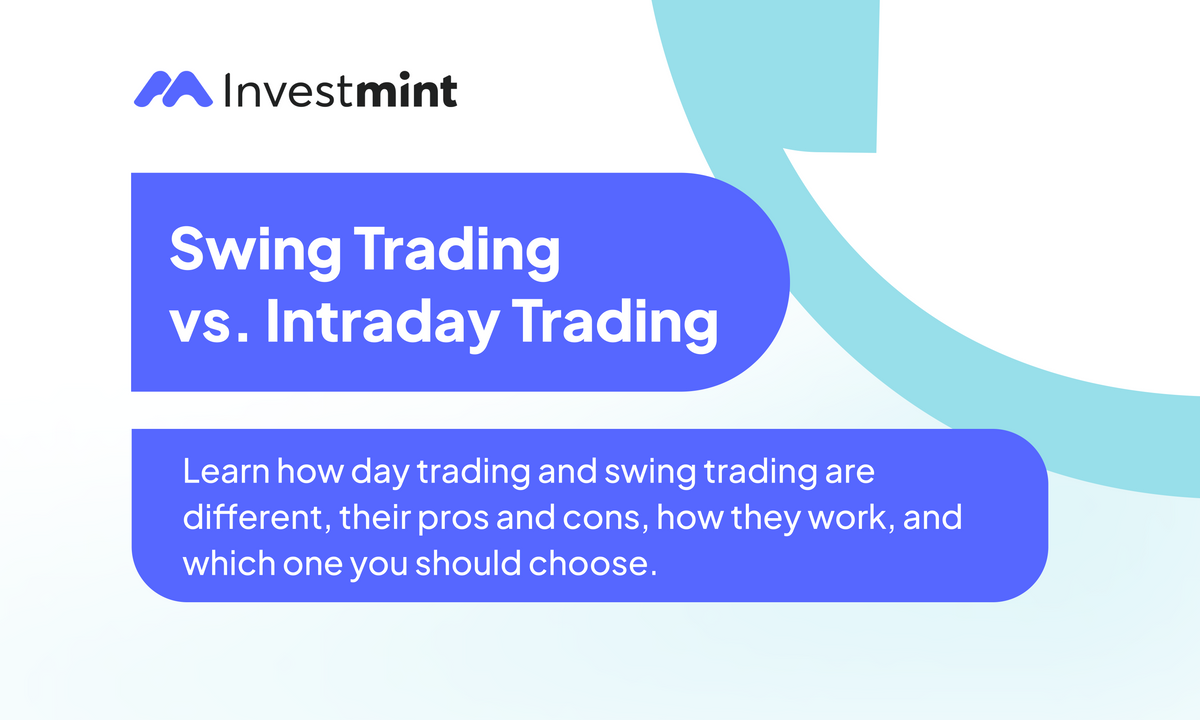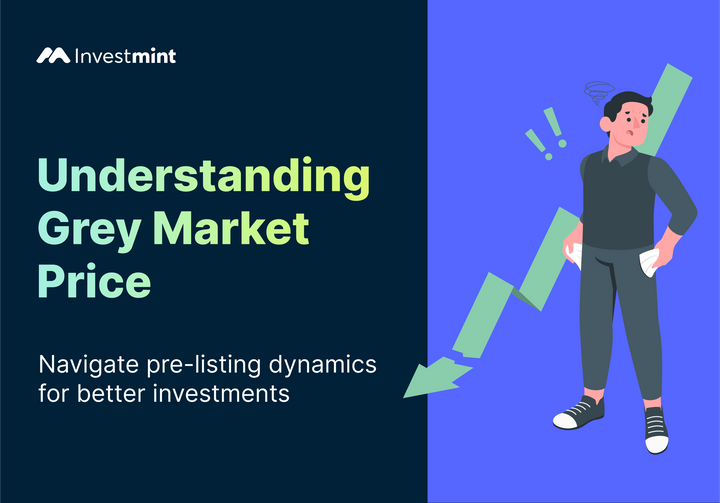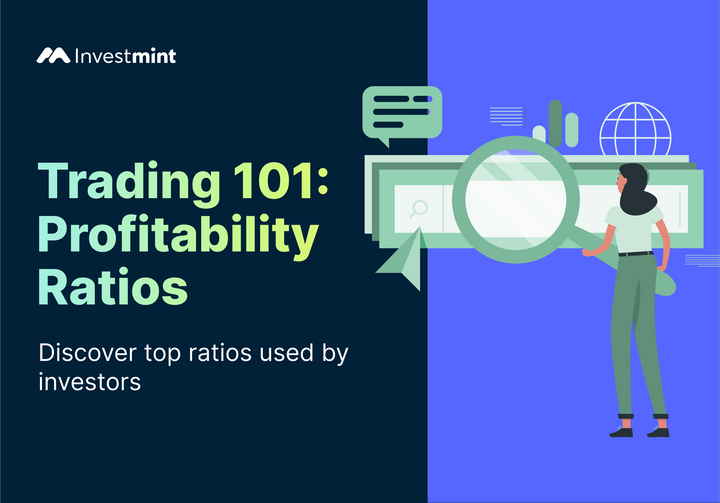Swing Trading vs. Intraday Trading - Which One to Choose?
Learn how day trading and swing trading are different, their pros and cons, how they work, and which one is right for you.

Introduction
When someone asks you why you invest in the stock market? What would your answer be?
As an investor in the stock market, you can have different approaches towards trading. It can either be to gain maximum profits in each trade or to create wealth over time. You may want to invest for long-term periods to accumulate a substantial treasury.
The other extreme is intraday trading wherein, you invest in short-term trades throughout the day and get returns on a daily basis.
Do you ever give a thought if there is anything between intraday and delivery trading? The answer is yes. It is called swing trading. The major difference between day trading and swing trading is the squaring off of positions on the same day.
The difference eventually boils down to the holding period of the stock. The article helps you get a hold of both concepts and decide what is more suitable for you
What Is Swing Trading?
Swing trading is where the investors buy a stock and hold on to it for a period of time. This is called the holding period.
The holding period for a stock in the case of swing trading is short. Generally, a swing trader holds the stock between a few days to a few weeks. The best time frame or holding period for swing trading if you have just started investing is within a week to a month.
Technical and pattern analysis is the tool that is often used to select a stock and perform trades. The analysis of stocks gives you an insight into when to buy the stock and when to go short on the stock.
Understand Some Pros and Cons for Swing Trading
Advantages of Swing Trading :
- Lesser monitoring - Swing trading requires less monitoring as compared to intraday trades. Swing trades require less time to execute and are comparatively easy to trade.
- Short-term profits -if you invest in bulk during market swings, short-term profits can be booked. Notable profits can be booked if the market goes uptrend.
- Flexible Trading -Swing trading allows you to sell or buy and hold stocks. This flexibility can prove to be a major plus point. You can avoid selling the stock at loss.
- Setting financial goals - Swing trading allows you to work alongside your financial goals. You can invest in a stock and exit the position once you have booked a profit.
Disadvantages of Swing Trading:
- False signals - Sometimes following a false signal might lead to accumulated losses.
- Early Exit - If you exit a position and the market surge after you trade, you can miss out on profits on the same stocks.
- Overnight risk - The market sentiment is highly fluctuating. Holding on to stocks leaves you exposed to overnight risks.
How to Execute a Swing Trade?
As a swing trader, you should look out for stocks with high volatility and high volume stocks.
- You should pick a stock that provides good returns in the short run. The fundamentals of the stock should be thoroughly examined before investing. You should have a trading account with a broker.
- A DEMAT account is where you can take the delivery of the stock.
- You can analyse the stock with different indicators such as Relative Strength Indicator (RSI), moving averages (MA) etc. A Stop-loss and a target price should be placed for the stock in a swing trade. A support level is the lowest point from which the stock price bounces upwards. A resistance level is the point where the stock prices stop going up and start to dip.
What Is Intraday Trading?
Intraday or day trading involves buying and selling financial instruments on the same day. You can book profits by banking on price fluctuations in the market. The holding time for stocks in day trading ranges from a few seconds to a few hours a day.
Day trading requires monitoring stocks and using technical indicators to decide when to exit a stock position in the market.
Is Intraday Trading Profitable?
To understand this, let us compare advantages and disadvantages of trading stocks intraday.
- There is no overnight risk - meaning, if the market crashes overnight due to some news, it doesn't affect you. In that sense, there is less risk. Think about it, there is only so much that the market can move within the span of a day.
- You can use leverage to maximise profits - The concept of leverage and margin is explained later in the post. Read that to understand it better; it can break your trading experience.
- The capital investment required in intraday trading is less due to available leverage.
- You can engage in Short selling, something that's possible only on an intraday time frame — an excellent strategy to profit from a stock's down move.
Disadvantages of Swing Trading:
- It's tough to profit based on intraday moves since the moves themselves are limited and there are thousands of stocks to choose from.
- If that is not enough, leverage can lead to more losses.
- Lastly, regarding trading costs and taxes, the more the transactions, the more the costs, and of course, you also would need to pay short-term capital gains on your profits. Since some of the costs like brokerage are fixed, a higher capital allocation is needed to cover the costs.
Day Trading vs. Swing trading
Which one is more profitable? Day trading or Swing trading?
You can indulge in day trading where the number of trades carried out is more. Notable profits are booked while these trades are squared off on a daily basis. On the contrary, the number of trades executed in a swing trade is less. This does not necessarily mean that the profit cannot be the same for both.
The strategy and skills required to achieve a profit in both cases are different. As a day trader, you focus more on daily and rapid price fluctuations. As a swing trader, your focal point is researching stocks with high growth potential.
Which trade carries more risk? Swing or Intraday?
We have always grown up listening to the fact, the greater the risk, the greater the return. Similarly, in the case of an intraday trade, we hold on to stocks overnight and thus the risks associated with swing trades are higher than intraday trades.
The amount we invest in swing trades is comparatively higher than intraday. So, if there is any significant movement in stocks due to volatility, the loss will be elevated as compared to intraday trades.
In the case of intraday trades, multiple trades are carried out and hence the profit or losses booked on these trades are also slighter than on swing trades.
Which Trading Strategy Is Meant for You – Swing or Intraday?
Trading in the stock market requires a thorough analysis of stocks and other factors. The right choice between swing and intraday depends upon the investment objective. The skills you acquire and the trading experience can help you make a better decision-maker.
What things should you consider before starting swing or intraday trading?
Before opting for swing trading strategies or intraday strategies, some factors should be scrutinised beforehand.
- Pace and stress - The intraday trading is executed with a tremendously high-speed pace. For beginners, this might be too much to handle. The stress is more since the volume and volatility of the stocks are continuously changing.
Swing trading is a recommended option for beginners because of the relatively slower pace and stress on the trader.
- Capital requirements - The capital requirement in the case of a swing trade is more than that of an intraday. The volume of stocks traded in swing trading might be lesser but the trading is capital-intensive.
The intraday trades offer more voluminous trading but are less capital-intensive and more accessible to traders.
- Focus and Freedom - In the case of swing trading, the major analysis required is fundamental and pattern analysis. This requires a certain amount of work to be done beforehand. But, as a trader, you have the freedom to choose the holding period.
In the case of intraday trading, a continuous focus is required and the trades are also automatically squared off by the end of the day.
- Taxation - Both intraday and swing trading profits or gains are liable to tax assuming that the holding period is one year as short-term capital gains. These short-term capital gains are liable to tax at the rate of 15%.
Parting Thoughts
Swing trading is one of the most advised methods of trading if you want to start trading in the market. It is active trading and provides a good amount of leverage and returns. As an investor thorough research on stocks and companies is all that is needed to start swing trading and avoid any loss-making decisions.
One should always assess risks before entering any trade and swing trading will provide you with an opportunity to analyse all your trading decisions.
Investmint app brings you the latest stock market updates. Ensure you capture today's opportunities by tapping below.



